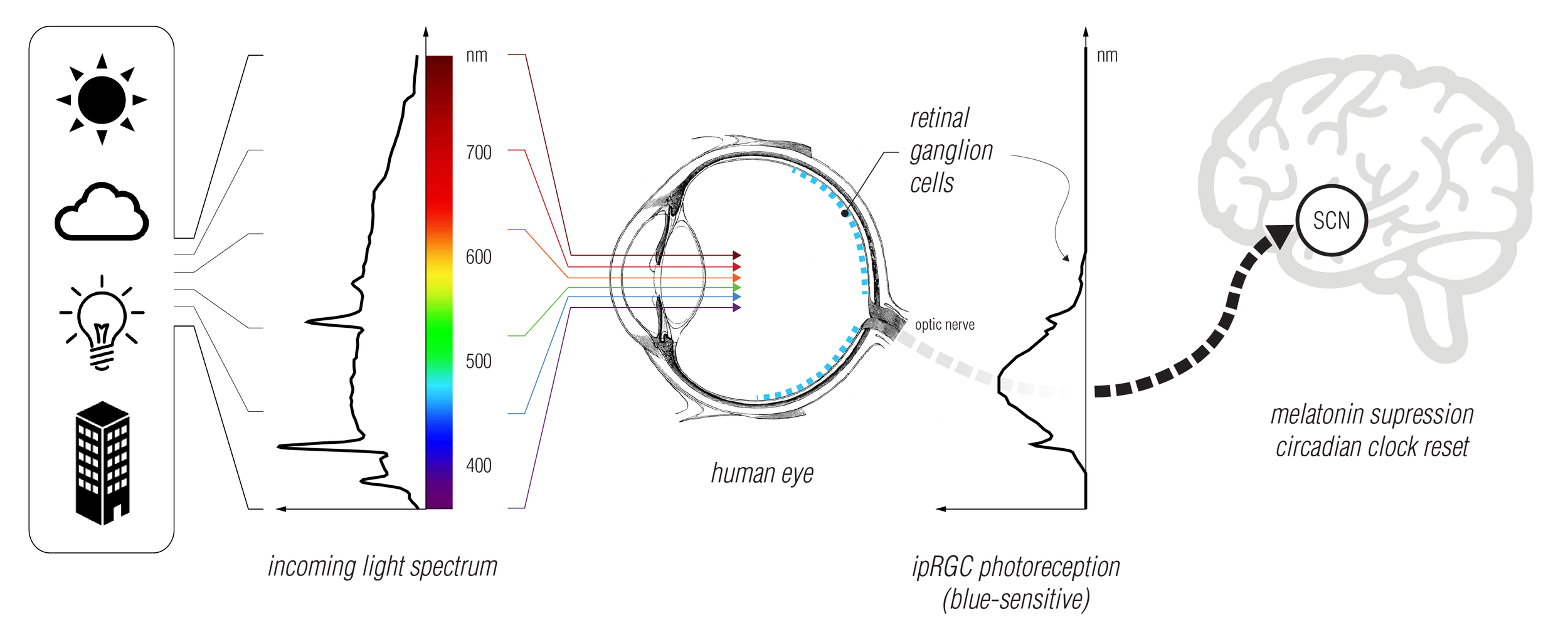Adaptive Lighting for Alertness
A new circadian lighting design software.
The human eye is not just for seeing. It also contains special photoreceptors (called intrinsically photosensitive retinal ganglion cells, or ipRGCs) that regulate alertness, sleep, and circadian rhythms. If exposed to the wrong types of light at the wrong times, these receptors can throw the brain’s internal clock out of sync with the outside world – compromising sleep quality, performance, and long-term health. ALFA – Adaptive Lighting for Alertness – is a new software that lets architects, lighting designers, and health professionals predict and control these non-visual effects, in order to create environments that are safer, healthier, and more productive. ALFA is a plugin for Rhinoceros 3D and requires the latest service release of version 6 or 7. Commercial or educational license key required.
SPECTRAL RAYTRACING
Because the non-visual system is sensitive to specific wavelengths of blue light, its activity cannot be described through traditional Red/Green/Blue color channels. To overcome this limitation, ALFA has extended the Radiance lighting engine to render the world in high-resolution, 81-color spectra.
MELANOPIC LUX
Spectral raytracing allows ALFA to predict the amount of light absorbed by an observer’s non-visual photoreceptors, given her location and direction of view. Since these receptors absorb light using the pigment melanopsin, the quantity is referred to as equivalent melanopic lux, or EML. Using ALFA, one can quickly predict EML for an array of view positions in any lighting environment.
HEALTHY LIGHTING CREDITS
Melanopic lux (EML) is already recognized by international building certification systems, including the WELL Building Standard. ALFA – the only tool capable of predicting EML through physically accurate, high spectral resolution simulations – makes it easy to calculate WELL Circadian Lighting credits, and includes adjustable targets to accommodate the needs of any project.
INTERACTIVE RENDERINGS
For any view position, ALFA provides an interactive, 360-degree rendering. Swivel the camera to observe the change in light spectrum and melanopic lux arriving at the eye. Or hover over pixels to see the spectral power distribution coming from any part of the scene.
SPECTRAL LUMINAIRES
In interior settings, the melanopic lux arriving at the eye is highly dependent on the wavelengths emitted by luminaires. ALFA comes with a library of high-resolution source spectra taken from measurements of real luminaires – making it easy to test the non-visual impact of specific lighting technologies.
SPECTRAL SKIES
The daytime sky is a powerful driver of circadian biology. Unlike (most) man-made light sources, it varies in color not only by time of day, but also by direction of view. To simulate it accurately, ALFA deploys spectral calculations using the best-in-class radiative transfer library, libRadtran. This lets ALFA users pull up physically-accurate clear, hazy, or overcast skies for any location on Earth.
SPECTRAL MATERIALS
Between emission from a source and arrival at the eye, light spectra are modified by transmission and reflection off material surfaces. To ensure realistic results, ALFA comes with a catalog of over 500 measured spectral materials, based on spectrophotometric measurements of real architectural objects. The software is also compatible with the International Glazing Database, making it easy to import any of the IGDB’s tens of thousands of spectrally measured glazing products.
WORKS WITH RHINO
ALFA comes with an enhanced user interface that is embedded into the Rhinoceros 3d CAD ecosystem.
ALFA video tutorial










